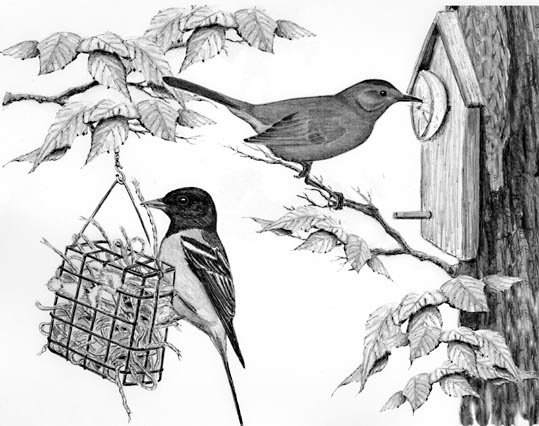
Dear Bird Folks,
I put a half an orange out, hoping to attract an oriole. It’s been a few days, but no orioles so far. However, a catbird found the orange and seems to be enjoying it. I didn’t know that catbirds liked oranges?
– Jay, Rocky Hill, CT
Now Jay,
No one is ever going to confuse me with an English teacher. A bodybuilder maybe, but never an English teacher. Still, I’m pretty sure that putting a question mark at the end of a statement doesn’t automatically qualify it as a question. Your last sentence, “I didn’t know that catbirds liked oranges?”, really isn’t a question. It’s more of a declaration or an admission. I’ve even tried saying it in a in tone, while raising my eyebrows, and I still couldn’t make it sound like a question. Try it if you don’t believe me and see for yourself. It’s okay, I’ll deal with it this time, but if you tried something like this on Jeopardy you’d be going home without any cash and perhaps without any lovely parting gifts.
Even with all the confusion I’m glad that you wrote in Jay, because your “statement” reminds me of a question that we get all the time. “When is the best time to feed birds?” My answer is always the same: “Feed birds anytime you want, but May is the best time.” May is when many birds look their best and May is when unusual, hungry migrants may stop in our yards looking for a quick snack before they continue on to their breeding grounds. In May our phone is lit up with calls about Indigo Buntings, Rose-breasted Grosbeaks and Scarlet Tanagers that have stopped in peoples’ yards, only to disappear after a few days. And May is when we see the return of the hummingbirds, orioles and catbirds, three of the most handsome and interesting birds that you’ll ever see at your feeders.
May is also when we can try new foods, other than sunflower seeds, to attract birds. Oranges are one of those foods. If you’ve never tried an orange, here’s what to do. Search the back of your refrigerator, behind the outdated container of rhubarb yogurt that you bought on sale, and find that one last orange from the case that your Florida relatives sent you for Christmas. Cut that orange in half and nail it to a branch, tree trunk or porch railing. With any luck you’ll be treated with a visit from a visually striking Baltimore Oriole or in your case Jay, an oriole that was apparently wearing a catbird suit.
Yes, catbirds like oranges, but what works best for me are raisins. Dried up old brown raisins, the cheapest you can find, will do the trick. You don’t need to soak them in water first or mix them with oatmeal and bake them into cookies. Simply put a handful of raisins on a plastic dish or on a board and the inquisitive catbirds will come out of nowhere to chow them down.
Jelly is another food to put out in May. Orioles, catbirds and even tanagers will come for a cup of jelly. Cheapo, cheapo grape jelly works fine, but feel free to use organic if you want to impress the neighbors. Then there are those delicious creepy, crawly meal worms. Meal worms are nothing more than harmless beetle larvae, but you can call them maggots if you like to freak people out. Most parent birds love to feed meal worms to their nestlings. The list of birds attracted to meal worms includes all that we have talked about already, plus bluebirds, wrens and just about any bird that is babies nearby.
Lastly, May is a good time to put out nesting material. Birds love to use pet fur to line their nests. You can collect it off your pet and put it outside in a basket or net bag. You can also do what I do. Simply open the window and let the birds fly in and pick the dog hair off the couch. The birds get a nice nest and I save on house keeping bills. Also, short 6″ pieces of string or yarn will be taken by many birds, especially orioles. However, be careful not to use long pieces of string because the birds will be in danger of getting tangled and you’ll be in danger of serious litigation.
Don’t be fooled into thinking that just because this food is different, you won’t have squirrels trying to get to it. You know better than that. And speaking of trying to get to food; I always keep meal worms in my refrigerator. I use them to feed the birds, but I also enjoy seeing my company discover the container full of chilled maggots when they are trying to sneak a snack. That will teach them.